Agricultural Regions
Agricultural Regions

agricultural region A geographic region defined by a distinctive combination of physical environmental conditions; crop type; settlement patterns; and labor, cultivation, and harvesting practices.
intensive agriculture A form of agriculture using mechanization, labor, and other capital to produce large crop yields relative to the amount of land being farmed.
How is the theme of culture region relevant to agriculture? For thousands of years, farmers have found ways to cope with a range of environmental conditions, creating in the process an array of different types of food-producing systems. Collectively, these farming practices have constructed formal agricultural regions (Figure 8.1). During the past 500 years, colonialism, industrialization, and globalization have greatly altered existing practices and created new types of agricultural regions, such as plantations. Increasingly, large-scale capitalist agriculture overcomes local environmental constraints through irrigation, land reclamation, and the use of synthetic fertilizers, chemical pesticides, herbicides, and genetic engineering. This form of large-scale farming using mechanization and other forms of capital, known as intensive agriculture, produces large crop yields per unit of land and therefore requires less land to produce profits than less intensive forms of farming. However, farmers engaging in intensive agriculture in large countries like the United States and Canada, where much agricultural land is available, choose to farm larger tracts of land in order to maximize investments in machinery and other capital. In parts of the world where agricultural land is scarcer, intensive agriculture is often practiced on smaller tracts of land located in high-value areas close to markets.
Agricultural Regions
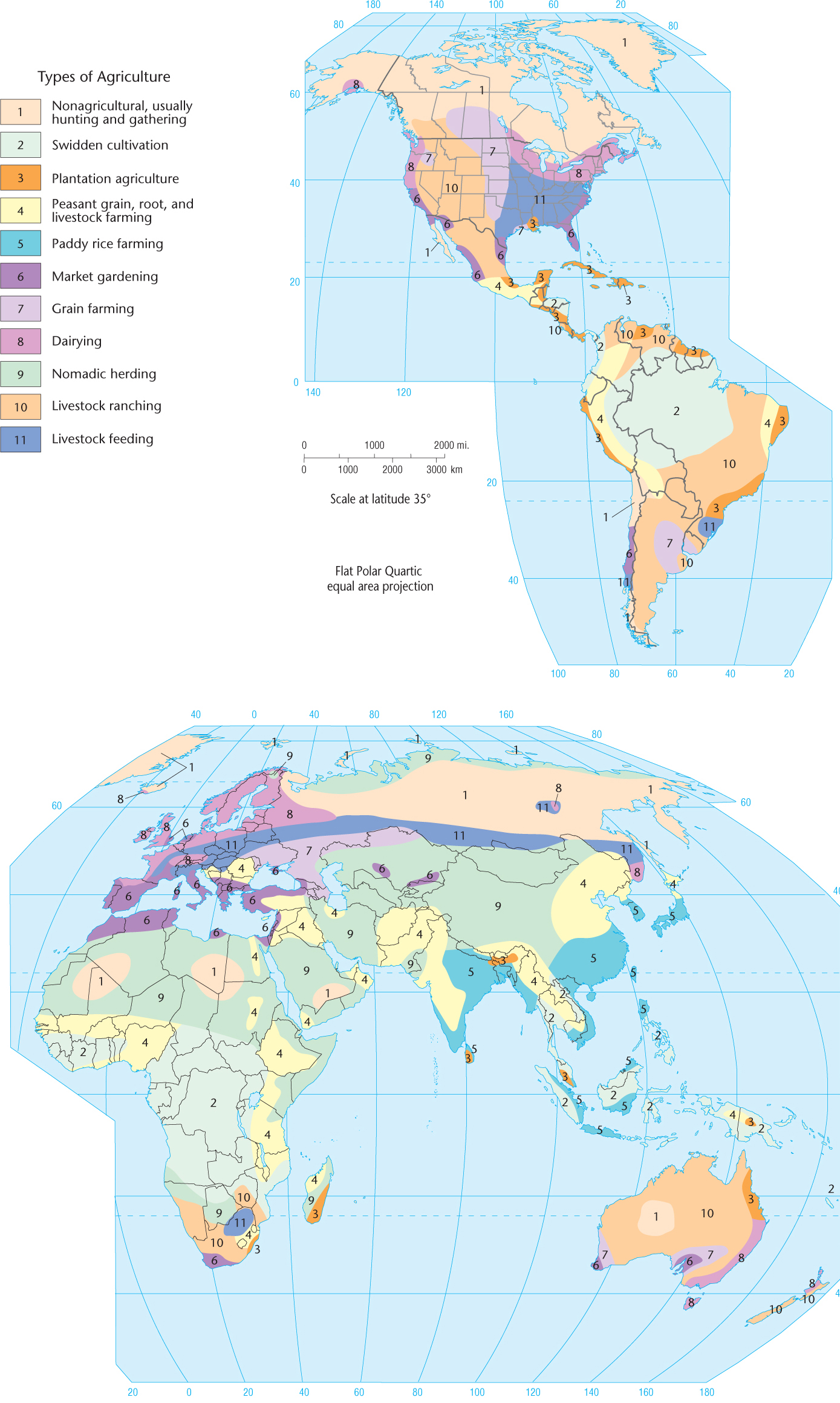
Thinking Geographically
Question 8.1
What type of agriculture is practiced where you live, according to this map? Do you agree with this classification? Explain.
215
extensive agriculture A less capital-intensive form of agriculture that is highly influenced by local environmental characteristics and often produces low crop yields per unit of land being farmed.
In contrast to intensive agriculture is a less mechanized, less capital-intensive form of farming known as extensive agriculture. In this type of farming, productivity is heavily affected by environmental characteristics in a local area such as soil fertility, terrain, water supply, and climate. Subsequently, in extensive agriculture, yields per unit of land are highly variable, making it necessary to farm larger tracts of land in order to ensure a profit. For this reason, extensive agriculture is normally practiced in areas where land values are low, such as in low-population-density areas or in areas at some distance from markets. Understanding the differing influences of environmental and economic forces on these different forms of agriculture, in addition to the influence of other cultural and political factors, is important for our understanding of agricultural regions.
Swidden (Shifting) Cultivation
Swidden (Shifting) Cultivation
swidden cultivation A type of agriculture characterized by land rotation in which temporary clearings are used for several years and then abandoned to be replaced by new clearings; also known as slash-and-burn agriculture.
intercropping (intertillage) The practice of growing two or more different types of crops in the same field at the same time.
Many of the peoples of tropical lowlands and hills in the Americas, Africa, and Southeast Asia practice a land-rotation agricultural system known as swidden cultivation. The term swidden is derived from an old English term meaning “burned clearing.” Using machetes, axes, and chainsaws, swidden cultivators chop away the undergrowth from small patches of land and kill the trees by removing a strip of bark completely around the trunk. After the dead vegetation dries out, the farmers set it on fire to clear the land. Because of these clearing techniques, swidden cultivation is also called slash-and-burn agriculture. Working with digging sticks or hoes, the farmers then plant a variety of crops in the ash-covered clearings, varying from the maize (corn), beans, bananas, and manioc of Native Americans to the yams and nonirrigated rice grown by hill tribes in Southeast Asia (Figure 8.2). Different crops typically share the same clearing, a practice called intercropping or intertillage. This technique allows taller, stronger crops to shelter lower, more fragile ones; reduces the chance of total crop losses from disease or pests; and provides the farmer with a varied diet. The complexity of many intercropping systems reveals the depth of knowledge acquired by swidden cultivators over many centuries. Relatively little tending of the plants is necessary until harvest time, and no fertilizer is applied to the fields because the ashes from the fire are a sufficient source of nutrients.
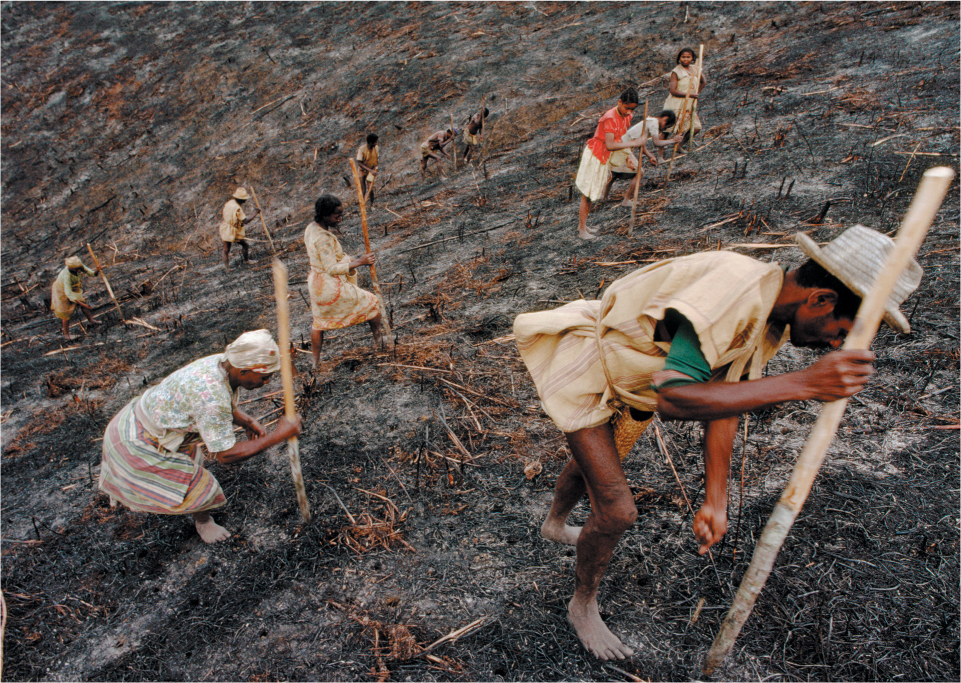
Thinking Geographically
Question 8.2
Are low-technology methods necessarily inferior?
subsistence agriculture Farming to supply the minimum food and materials necessary to survive.
The planting and harvesting cycle is repeated in the same clearings for perhaps three to five years, until soil fertility begins to decline as nutrients are taken up by crops and not replaced. Subsequently, crop yields decline. These fields then are abandoned, and new clearings are prepared to replace them. Because the farmers periodically shift their cultivation plots, another commonly used term for the system is shifting cultivation. The abandoned cropland lies fallow for 10 to 20 years before farmers return to clear it and start the cycle again. Swidden cultivation represents one form of subsistence agriculture—food production mainly for the family and local community rather than for market.
Swidden cultivation in the tropics often has been viewed by outsiders as destructive and inefficient, because the techniques used and the landscapes that result are so different from those common in temperate-zone agriculture. However, although the technology of swidden may be simple, it has proved to be an efficient and adaptive strategy. Swidden farming, unlike some modern systems, is ecologically sustainable and has endured for millennia. Indeed, contemporary studies suggest that some swidden systems have actually enhanced biodiversity. Furthermore, swidden returns more calories of food for the calories spent on cultivation than does modern mechanized agriculture. In many tropical forest regions, swidden cultivation, unlike Western plantations, has left most of the forest intact over centuries of continuous use.
Nonetheless, swidden cultivation can be environmentally destructive under certain conditions. In poor countries with large landless populations, one often finds a front of pioneer swidden farmers advancing on the forests. In such situations, a range of institutional, economic, political, and demographic factors restrict poor farmers’ abilities to employ the methods of swidden agriculture in a sustainable way. In many tropical countries, for example, a small proportion of the population owns most of the best agricultural land, forcing the majority of farmers to clear forests to gain access to land. Another condition that may diminish the sustainability of swidden cultivation occurs when a population experiences a sudden increase in its rate of growth and political or social conditions restrict its mobility. Population growth may encourage farmers to shorten the period during which the land is recuperating, a departure from past practices that can lead to environmental deterioration.
217
Paddy Rice Farming
Paddy Rice Farming
paddy rice farming The cultivation of rice on a paddy, or small flooded field enclosed by mud dikes, practiced in the humid areas of the Far East.
Peasant farmers in the humid tropical and subtropical parts of Asia practice a highly distinctive type of subsistence agriculture called paddy rice farming. A paddy is a small flooded field enclosed by mud dikes, usually found in the humid areas of the Far East. Rice, the dominant paddy crop, forms the basis of civilizations in which almost all the caloric intake is of plant origin. From the monsoon coasts of India through the hills of southeastern China and on to the warmer parts of Korea and Japan stretches a broad region of diked, flooded rice fields or paddies, many of which are perched on terraced hillsides (Figure 8.3). The terraced paddy fields form a striking cultural landscape (see Figure 1.18, p. 22).

Thinking Geographically
Question 8.3
What are the disadvantages of such a system?
double-cropping Harvesting twice a year from the same parcel of land.
A paddy rice farm of only 3 acres (1 hectare = 2.47 acres) usually is adequate to support a family, because irrigated rice provides a very large output of food per unit of land. Still, paddy farmers must till their small patches intensively to harvest enough food. A system of irrigation that can deliver water when and where it is needed is key to success. In addition, large amounts of fertilizer must be applied to the land. Paddy farmers often plant and harvest the same parcel of land twice per year, a practice known as double-cropping. These systems are extremely productive, yielding more food per acre than many forms of industrialized agriculture in the United States.
The modern era has witnessed a restructuring of paddy rice farming in more developed countries, such as Japan, Korea, and Taiwan. In some cases, the terrace structure has been reengineered to produce larger fields that can be worked with machines. In addition, dams, electric pumps, and reservoirs now provide a more reliable water supply, and high-yielding seeds, pesticides, and synthetic fertilizers boost production further. Most paddy rice farmers now produce mainly for urban markets.
commercial agriculture The growing of crops, including nonfood crops, for sale rather than strictly for consumption by one’s own family.
This production of paddy rice crops for sale in external markets, rather than solely for consumption by one’s own family, is one type of commercial agriculture. There are other types of commercial agriculture as well, including plantation agriculture, that produce food for sale to wholesale and retail markets. The production of nonfood crops like cotton and tobacco is considered commercial agriculture because these commodities cannot be used directly to feed farming families.
Peasant Grain, Root, and Livestock Farming
Peasant Grain, Root, and Livestock Farming
peasant A farmer belonging to a folk culture and practicing a traditional system of agriculture.
folk culture Small, cohesive, stable, isolated, nearly self-sufficient group that is homogeneous in custom and race; characterized by a strong family or clan structure, order maintained through sanctions based in the religion or family, little division of labor other than that between the sexes, frequent and strong interpersonal relationships, and material cultures consisting mainly of handmade goods.
In colder, drier Asian farming regions that are climatically unsuited to paddy rice farming—as well as in the river valleys of the Middle East, in parts of Europe, in Africa, and in the mountain highlands of Latin America and New Guinea—farmers practice a diverse system of agriculture based on bread grains, root crops, and herd livestock (Figure 8.4 and Figure 8.5). Many geographers refer to these farmers as peasants, recognizing that they often represent a distinctive folk culture strongly rooted in the land. Peasants generally are small-scale farmers who own their fields and produce both for their own subsistence and for sale in the market. The dominant grain crops in these regions are wheat, barley, sorghum, millet, oats, and maize. Common cash crops—some of them raised for export—include cotton, flax, hemp, coffee, and tobacco.
218
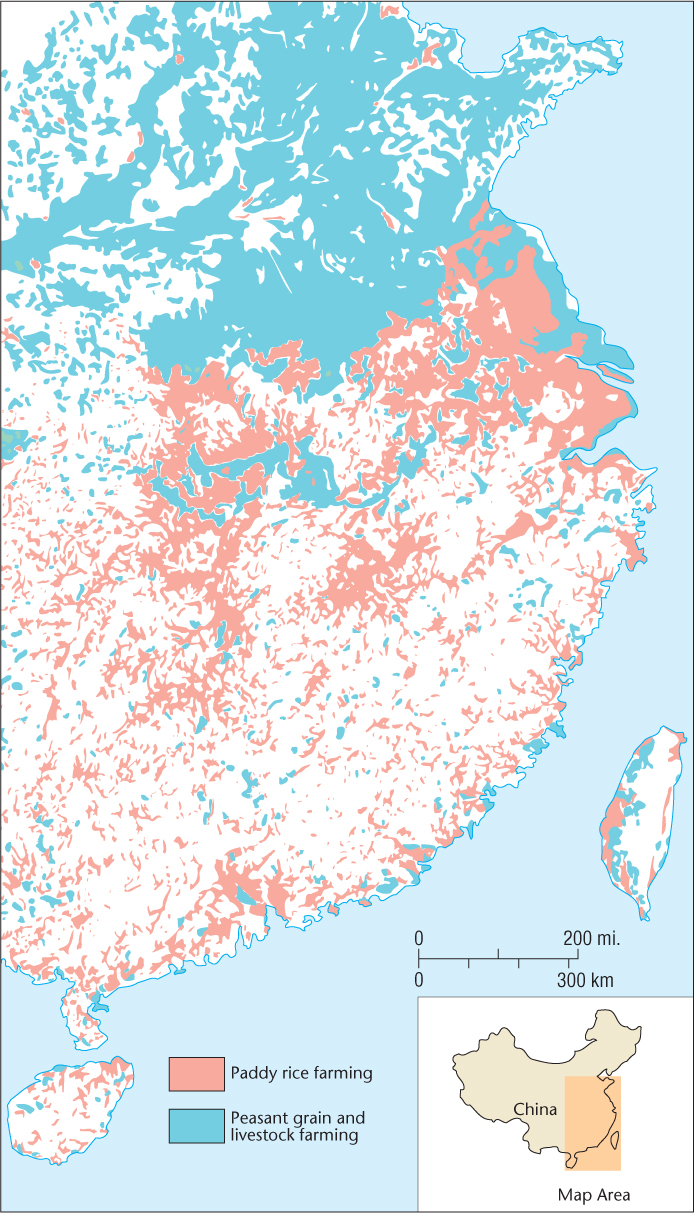
Thinking Geographically
Question 8.4
What might account for the more fragmented distribution of paddy rice farming, as contrasted with peasant grain and livestock farming? Where would you draw the cultural boundary between the two types of agriculture?
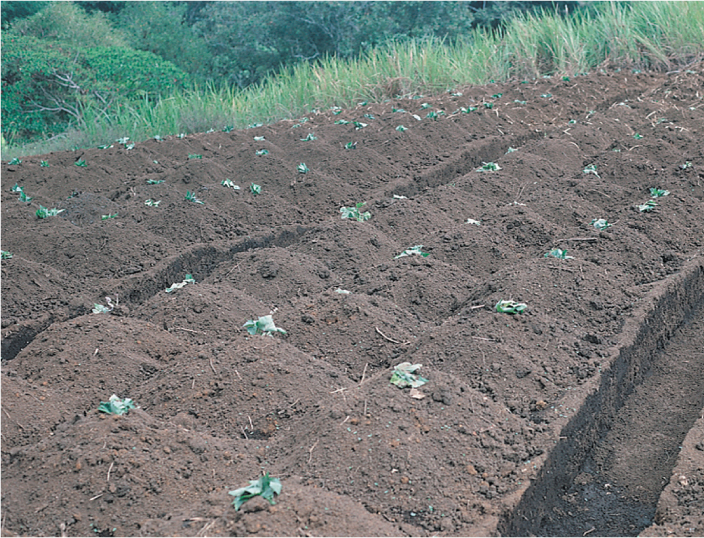
Thinking Geographically
Question 8.5
Why might the people go to the trouble of creating these small mounds?
These farmers also raise herds of cattle, pigs, sheep, and, in South America, llamas and alpacas. The livestock pull the plow; provide milk, meat, and wool; serve as beasts of burden; and produce manure for the fields. They also consume a portion of the grain harvest. In some areas, such as the Middle Eastern river valleys, the use of irrigation helps support this peasant system. In general, however, modern agricultural technologies are beyond the financial reach of most peasants.
Plantation Agriculture
Plantation Agriculture
plantation agriculture A system of monoculture for producing export crops requiring relatively large amounts of land and capital; originally dependent on slave labor.
plantation A large landholding devoted to specialized production of a single tropical cash crop.
In certain tropical and subtropical areas, Europeans and Americans introduced a commercial agricultural system called plantation agriculture. A plantation is a landholding devoted to capital-intensive, large-scale, specialized production of one tropical or subtropical crop for the global market. Each plantation district in the tropical and subtropical zones tends to specialize in one crop. Plantation agriculture has long relied on large amounts of manual labor, initially in the form of slave labor and later as wage labor. The plantation system originated in the 1400s on Portuguese-owned sugarcane-producing islands off the coast of tropical West Africa—São Tomé and Príncipe—but the greatest concentrations are now in the American tropics, Southeast Asia, and tropical South Asia. Most plantations lie near the seacoast, close to the shipping lanes that carry their produce to nontropical lands such as Europe, the United States, and Japan.
219
Workers usually live right on the plantation, where a rigid social and economic segregation of labor and management produces a two-class society of the wealthy and the poor. As a result of the concentration of ownership and production, a handful of multinational corporations, such as Chiquita and Dole, control the largest share of plantations globally. Tension between labor and management is not uncommon, and the societal ills of the plantation system remain far from cured (Figure 8.6).

Thinking Geographically
Question 8.6
How does this message suggest that in fact not all is harmonious here and that the tension of the two-class plantation system simmers below the surface?
Plantations provided the base for European and American economic expansion into tropical Asia, Africa, and Latin America. They maximize the production of luxury crops for Europeans and Americans, such as sugarcane, bananas, coffee, coconuts, spices, tea, cacao, pineapples, rubber, and tobacco (Figure 8.7). Similarly, textile factories require cotton, sisal, jute, hemp, and other fiber crops from the plantation areas. Much of the profit from these plantations is exported, along with the crops themselves, to Europe and North America, another source of political friction between countries of the global North and South.
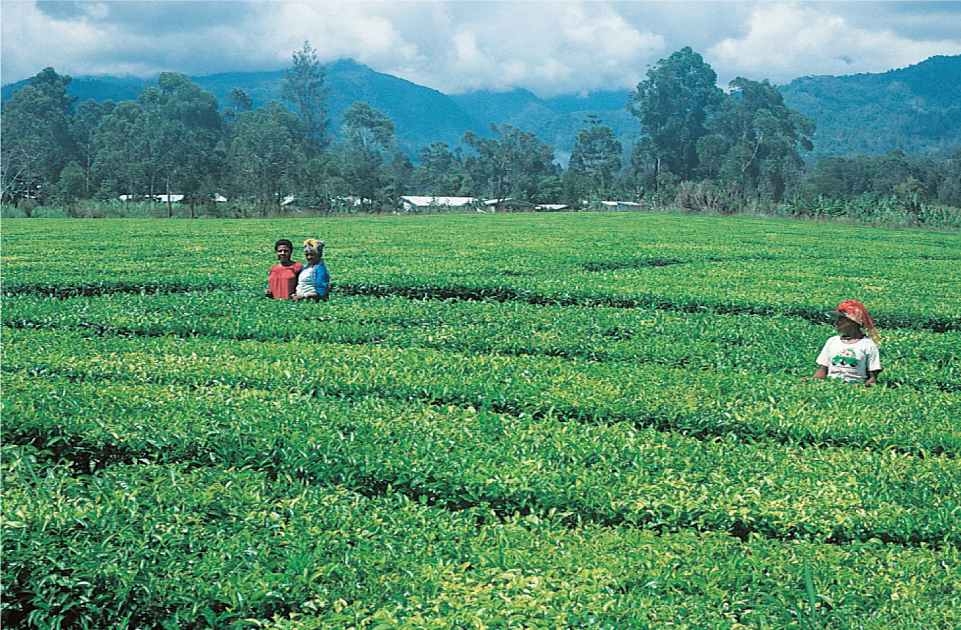
Thinking Geographically
Question 8.7
Should the government have prevented such a displacement?
220
Market Gardening
Market Gardening
market gardening Farming devoted to specialized nontropical fruit, vegetable, or vine crops for sale rather than consumption. Also known as truck farming.
The growth of urban markets in the last few centuries also gave rise to other commercial forms of agriculture, including market gardening, also known as truck farming. Unlike plantations, truck farms are located in developed countries and specialize in intensively cultivated nontropical fruits, vegetables, and vines. They raise no livestock. Many districts concentrate on a single product, such as wine, table grapes, raisins, olives, oranges, apples, lettuce, or potatoes, and the entire farm output is raised for sale rather than for consumption on the farm. Many truck farmers participate in cooperative marketing arrangements and depend on migratory seasonal farm laborers to harvest their crops. Market garden districts appear in most industrialized countries. In the United States, a broken belt of market gardens extends from California eastward through the Gulf and Atlantic coast states, with scattered districts in other parts of the country. (Figure 8.8 provides an overview of U.S. agricultural patterns.) The lands around the Mediterranean Sea are dominated by market gardens. In regions of mild climates, such as California, Florida, and the Mediterranean region, winter vegetables are a common market crop raised for sale in colder regions of the higher latitudes.
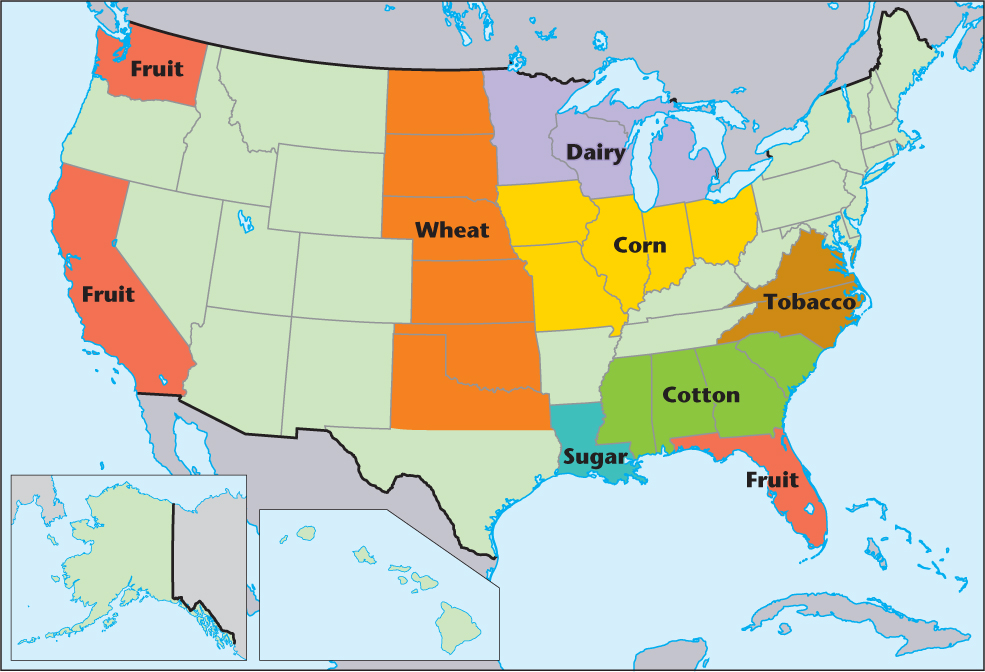
Thinking Geographically
Question 8.8
How do you explain the absence of major crop-producing regions in the western Great Plains and intermountain region of the United States?
Livestock Feeding
Livestock Feeding
livestock feeding A commercial type of agriculture that produces cattle and hogs for meat.
In livestock feeding, farmers raise and fatten cattle and hogs for slaughter. One of the most highly developed meat industry areas is the famous Corn Belt of the U.S. Midwest, where farmers raise corn and soybeans to feed cattle and hogs. Typically, slaughterhouses are located close to feedlots, creating a new meat-producing region, which is often dependent on mobile populations of cheap immigrant labor. A similar system prevails over much of western and central Europe, though the feed crops there more commonly are oats and potatoes. Other zones of commercial livestock feeding appear in overseas European settlement zones such as southern Brazil and South Africa.
feedlot A factorylike farm devoted to livestock feeding or dairying; typically all feed is imported and no crops are grown on the farm.
One of the central traditional characteristics of livestock feeding is the combination of crops and animal husbandry. Farmers breed many of the animals they feed out, especially hogs. In the last half of the twentieth century, livestock feeders began to specialize their activities; some concentrated on breeding animals, others on preparing them for market. In the factory-like feedlot, farmers raise imported cattle and hogs on purchased feed (Figure 8.9). Increases in the amount of land and crop harvest dedicated to beef production have accompanied the growth in feedlot size and number. In the United States, across Europe, and in European settlement zones around the globe, 51 to 75 percent of all grain raised goes to livestock feeding.

Thinking Geographically
Question 8.9
What ecological problems might such an enterprise cause?
The livestock feeding and slaughtering industry has become increasingly concentrated, on both the national and global scales. In 1980 in the United States, the top four companies accounted for 41 percent of all slaughtered cattle. By 2000, the top four companies were slaughtering 81 percent of all feedlot cattle.
221
Grain Farming
Grain Farming
Grain farming is a type of specialized agriculture in which farmers grow primarily wheat, rice, or corn for commercial markets. The United States is the world’s leading wheat and corn exporter. (Figure 8.8 highlights the dominant corn-producing area in the Midwest.) Climate and soil types in this region are ideally suited to growing corn, while proximity to the Great Lakes shipping corridor allows for convenient transport of corn crops to major markets on the East Coast and to markets abroad.
The United States, Canada, Australia, the European Union (EU), and Argentina together account for more than 85 percent of all wheat exports, while the United States alone accounts for about 70 percent of world corn exports. Wheat belts stretch through Australia, the Great Plains of interior North America, the steppes of Russia and Ukraine, and the pampas of Argentina. Farms in these areas generally are very large, ranging from family-run wheat farms to giant corporate operations (Figure 8.10).
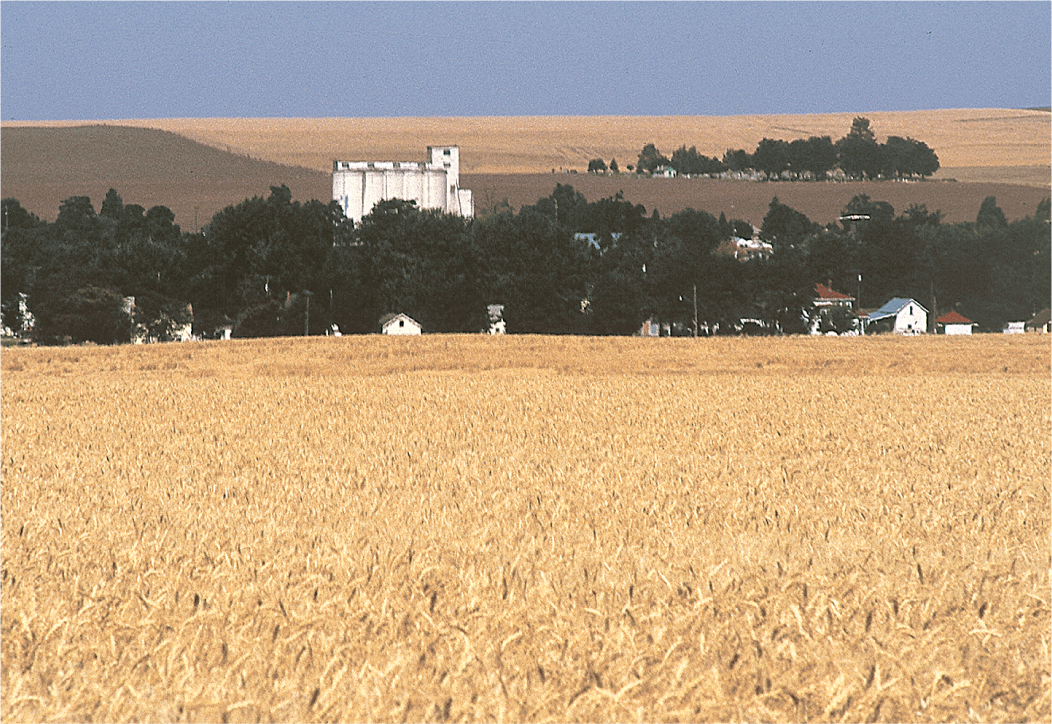
Thinking Geographically
Question 8.10
What problems might be linked to monoculture?
suitcase farm In U.S. commercial grain agriculture, a farm on which no one lives; planting and harvesting are done by hired migratory crews.
Widespread use of machinery, synthetic fertilizers, pesticides, and genetically engineered seed varieties enables grain farmers to operate on this large scale. The planting and harvesting of grain are more completely mechanized than any other form of agriculture. Commercial rice farmers employ such techniques as sowing grain from airplanes. Harvesting is usually done by hired migratory crews using corporation-owned machines (Figure 8.11). Perhaps grain farming’s ultimate development is the suitcase farm, which is found in the Wheat Belt of the northern Great Plains of the United States. The people who own and operate these farms do not live on the land. Most of them own several suitcase farms, lined up in a south-to-north row through the Plains states. They keep fleets of farm machinery, which they send north with crews of laborers along the string of suitcase farms to plant, fertilize, and harvest the wheat. The progressively later ripening of the grain as one moves north allows these farmers to maintain and harvest crops on all their farms with the same crew and the same machinery. Except for visits by migratory crews, the suitcase farms are uninhabited.

Thinking Geographically
Question 8.11
What long-term problems might such methods cause? What benefits are realized in such a system?
222
agribusiness Highly mechanized large-scale farming, usually under corporate ownership.
Such highly mechanized, absentee-owned, large-scale operations, or agribusinesses, have mostly replaced the small, husband- and wife-operated American family farm, an important part of the U.S. rural heritage. Geographer Ingolf Vogeler documented the decline of the small family farms in the American countryside and argued that U.S. governmental policies, prompted by the forces of globalization, have consistently favored the interests of agribusiness, thereby hastening the decline. Family-owned farms continue to play an important role, but they now operate mostly as large agribusinesses that own or lease many far-flung grain fields.
Dairying
Dairying
In many ways, the specialized production of dairy goods closely resembles livestock farming. In the large dairy belts of the northern United States from New England to the upper Midwest, western and northern Europe, southeastern Australia, and northern New Zealand, the keeping of dairy cows depends on the large-scale use of pastures. In colder areas, some acreage must be devoted to winter feed crops, especially hay. Dairy products vary from region to region, depending in part on how close the farmers are to their markets. Dairy belts near large urban centers usually produce milk, which is more perishable, while those farther away specialize in butter, cheese, or processed milk. An extreme case is New Zealand, which, because of its remote location from world markets, produces much butter.
Reflecting on Geography
Question 8.12
Why is dairying confined to northern Europe and the overseas lands settled by northern Europeans? (See Figure 8.1.)
As with livestock feeding, in recent decades a rapidly increasing number of dairy farmers have adopted the feedlot system and now raise their cattle on feed purchased from other sources. Often situated on the suburban fringes of large cities for quick access to market, the dairy feedlots operate like factories. Like industrial factory owners, feedlot dairy owners rely on hired laborers to help maintain their herds. Dairy feedlots are another indicator of the rise of globalization-induced agribusiness and the decline of the family farm. By easing trade barriers, globalization compels U.S. dairy farmers to compete with producers in other parts of the world. Huge feedlots, a factory-style organization of production, automation, the concentration of ownership, and the increasing size of dairy farms are responses to this intense competition.
Nomadic Herding
Nomadic Herding
nomadic livestock herder A member of a group that continually moves with its livestock in search of forage for its animals.
In the dry or cold lands of the Eastern Hemisphere, particularly in the deserts, prairies, and savannas of Africa, the Arabian Peninsula, and the interior of Eurasia, nomadic livestock herders graze cattle, sheep, goats, and camels. North of the tree line in Eurasia, the cold tundra forms a zone of nomadic herders who raise reindeer. The common characteristic of all nomadic herding is mobility. Herders move with their livestock in search of forage for the animals as seasons and range conditions change. Some nomads migrate from lowlands in winter to mountains in summer; others shift from desert areas during the rainy season to adjacent semiarid plains in the dry season or from tundra in summer to nearby forests in winter. Some nomads herd while mounted on horses, such as the Mongols of East Asia, or on camels, such as the Bedouin of the Arabian Peninsula. Others, such as the Rendile of East Africa, herd cattle, goats, and sheep on foot.
223
Their need for mobility dictates that the nomads’ few material possessions be portable, including the tents or huts used for housing (Figure 8.12). Their mobile lifestyle also affects how wealth is measured. Typically, in nomadic cultures wealth is based on the size of livestock holdings rather than on the accumulation of property and personal possessions. Usually, the nomads obtain nearly all of life’s necessities from livestock products or by bartering with the farmers of adjacent river valleys and oases.
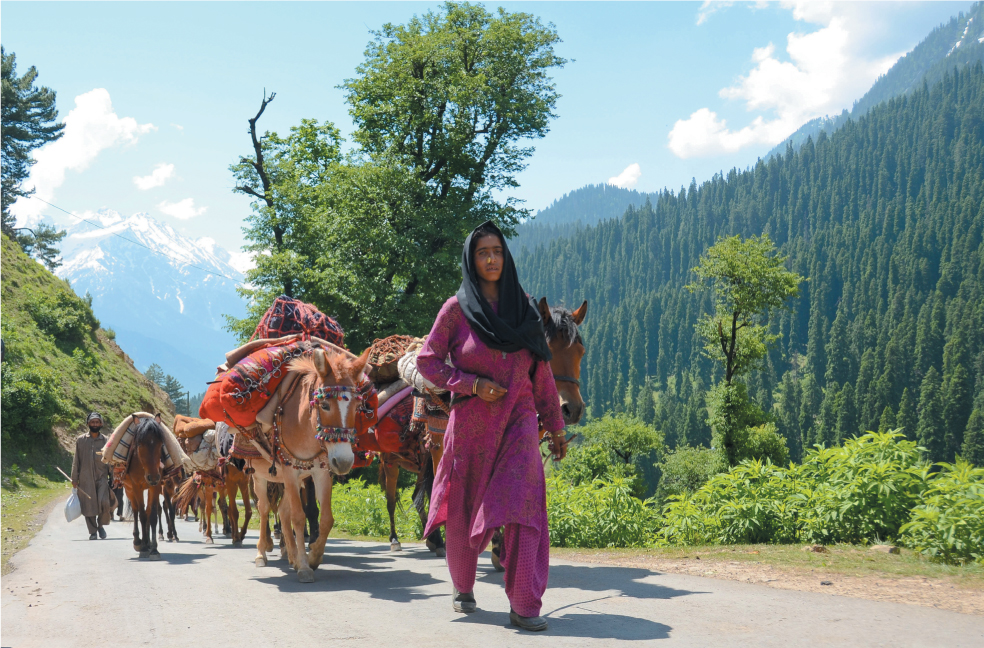
Thinking Geographically
Question 8.13
What are the hazards of this agricultural system?
sedentary cultivation Farming in fixed and permanent fields.
For a number of different reasons, nomadic herding has been in decline since the early twentieth century. Some national governments established policies encouraging nomads to practice sedentary cultivation of the land, meaning farming in fixed and permanent fields. This practice was begun in the nineteenth century by British and French colonial administrators in North Africa, because it allowed greater control of the people by the central governments. Today, many nomads are voluntarily abandoning their traditional life to seek jobs in urban areas or in the Middle Eastern oil fields. Severe drought in sub-Saharan Africa’s Sahel region, which decimated nomadic livestock herds, was a further impetus to abandon nomadic life.
In recent decades, research conducted by geographers and anthropologists in Africa’s semiarid environments has revealed the sound logic of nomadic herding practices. These studies demonstrate that nomadic cultures’ pasture and livestock management strategies are rational responses to an erratic and unpredictable environment. Rainfall is highly irregular in time and space, and herding practices must adjust. The most important nomadic strategy is mobility, which allows herders to take fullest advantage of the resulting variations in range productivity. These findings have led to a new appreciation of nomadic herding cultures and may cause governments to reconsider sedentarization programs, thus postponing the demise of herding cultures.
Livestock Ranching
Livestock Ranching
ranching The commercial raising of herd livestock on a large landholding.
Superficially, ranching might seem similar to nomadic herding. It is, however, a fundamentally different livestock-raising system. Although both nomadic herders and livestock ranchers specialize in animal husbandry and both live in arid or semiarid regions, livestock ranchers have fixed places of residence and operate as individuals rather than within a communal or tribal organization. In addition, ranchers raise livestock on a large scale for market, not for their own subsistence.
224
Livestock ranchers are found worldwide in areas with environmental conditions that are too harsh for crop production. They raise only two kinds of animals in large numbers: cattle and sheep. Ranchers in the United States, Canada, tropical and subtropical Latin America, and the warmer parts of Australia specialize in cattle raising. Mid-latitude ranchers in cooler and wetter climates specialize in sheep. Sheep production is geographically concentrated to such a degree that only three countries (Australia, China, and New Zealand) account for 56 percent of the world’s export wool.
Urban Agriculture
Urban Agriculture
urban agriculture The raising of food, including fruit, vegetables, meat, and milk, inside cities, especially common in developing countries.
The United Nations (UN) calculates that in 2008 the human species passed a milestone. For the first time in history, more people are living in cities than in the countryside. As this global-scale rural-to-urban migration gained momentum, a distinct form of agriculture rose in significance. We might best call this urban agriculture. Millions of city dwellers, especially in developing countries, now produce enough vegetables, fruit, meat, and milk from tiny urban or suburban plots to provide most of their food, often with a surplus to sell. In China, urban agriculture now provides 90 percent or more of all the vegetables consumed in the cities. In the African metropolises of Kampala and Dar es Salaam, 70 percent of the poultry and 90 percent of the leafy vegetables consumed in the cities, respectively, come from urban lands. Even a developed country such as Russia derives nearly half of its food from such operations. Similarly, neighborhood gardens increasingly are found in inner-city areas of North America.
Geographer Susanne Freidberg has conducted research demonstrating the importance of urban agriculture to family income and food security in West Africa. Focusing on the city of Bobo-Dioulasso in Burkina Faso, Freidberg showed that though plots were small, urban agriculture offered residents “a culturally meaningful way to fulfill their roles as food producers and family providers.” In its heyday in the 1970s and 1980s, urban farming provided substantial incomes from vegetable sales in both the domestic and export markets. Since then, collapsing demand and the deterioration of environmental conditions have threatened the enterprise and undermined cooperation and trust within Bobo-Dioulasso’s urban agricultural communities.
Farming the Waters
Farming the Waters
aquaculture The cultivation and harvesting of aquatic organisms under controlled conditions.
mariculture A branch of aquaculture specific to the cultivation of marine organisms, often involving the transformation of coastal environments and the production of distinctive new landscapes.
Most of us don’t think of the ocean when discussing agriculture. In fact, every year more and more of our animal protein is produced through aquaculture: the cultivation and harvesting of aquatic organisms under controlled conditions. Aquaculture includes mariculture, which often involves the transformation of coastal environments and the production of distinctive landscapes. Modern aquaculture includes shrimp farming, oyster farming, fish farming, pearl cultivation, and more. In the heart of Brooklyn, New York, urban aquaculture thrives in a laboratory, where fish bound for New York City restaurants are harvested from indoor tanks. Aquaculture has its own distinctive cultural landscapes of containment ponds, rafts, nets, tanks, and buoys (Figure 8.13). Like terrestrial agriculture, there is a marked regional character to aquacultural production.
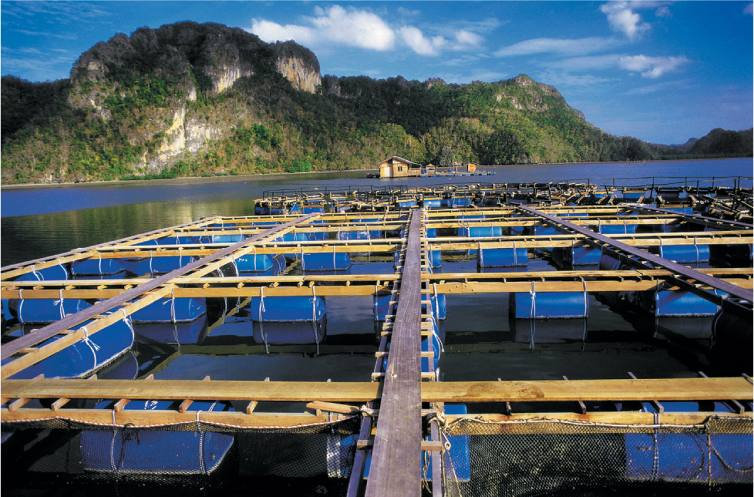
Thinking Geographically
Question 8.15
Is mariculture a better solution to the need for protein in a growing population than land-based livestock farming? Explain.
Aquaculture is an ancient practice, dating back at least 4500 years. Older local practices, sometimes referred to as traditional aquaculture, involve simple techniques such as constructing retention ponds to trap fish or seeding flooded rice fields with shrimp. Commercial aquaculture, the industrialized, large-scale protein factories that are driving today’s production growth, is a contemporary phenomenon. The greatest leaps in technology and production have occurred mostly since the 1970s.
225
In the twenty-first century, aquaculture is experiencing phenomenal growth worldwide, growing nearly four times faster than all terrestrial animal food-producing sectors combined. Aquaculture is a key reason that per capita protein availability has mostly kept pace with population growth in recent decades. Aquaculture’s share of production is projected to continue growing as demand for seafood increases and wild fish stocks decline.
The extraordinary expansion of food production by aquaculture has come with high costs to the environment and human health. As with the rest of industrialized agriculture, most commercial aquaculture relies on high energy and chemical inputs, including antibiotics and artificial feeds made from the wastes of poultry and hog processing. Such production practices tend to concentrate toxins in farmed fish, creating a potential health threat to consumers. The discharge from fish farms, which can be equivalent to the sewage from a small city, can pollute nearby natural aquatic ecosystems.
Although aquaculture can take place just about anywhere that water is found, strong regional patterns do exist. Mariculture is prevalent along tropical coasts, particularly in the mangrove forest zone. Marine coastal zones in general, especially in protected gulfs and estuaries, have high concentrations of mariculture. On a global scale, China dwarfs all other regions, producing over two-thirds of the world’s farmed seafood (Figure 8.14). Asia and Pacific regions combined produce over 90 percent of the world’s total.
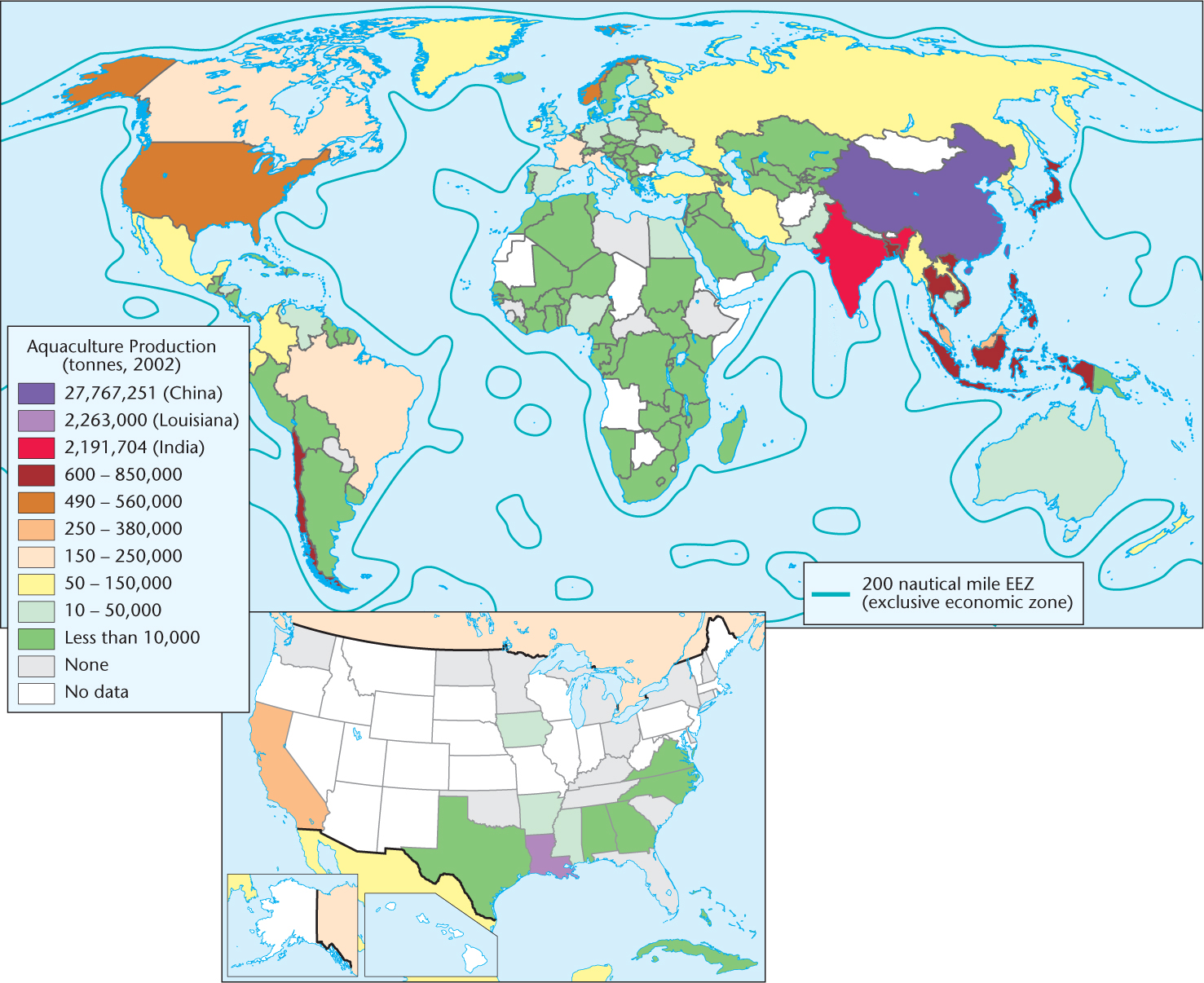
Thinking Geographically
Question 8.16
Why would China be so interested in developing aquaculture?
226
Globally, the right to engage in mariculture, along with other maritime economic activities such as fishing and undersea mining, is governed by the delimitation of exclusive economic zones (EEZs). Under the United Nations Law of the Sea, states possessing coastline, or governing territories with coastline, are granted an extension of their boundaries out into the sea for the purposes of engaging in exploration and the use of marine resources. Generally, this zone is defined by a 200-nautical-mile limit from a country’s coast. The United States has the largest EEZ of any country on Earth due to its extensive coastline and many island territories (Figure 8.15). This expansive EEZ has often been a source of political tension between the United States and other states possessing lesser opportunities for exploiting ocean resources for economic gain. In recent decades, debates between countries regarding EEZ rights have escalated in light of increasing global resource scarcities and environmental degradation. Overfishing, oil spills, and the dumping of waste are but a few potential sources of marine resource endangerment. As resource demands continue to increase, the conservation and protection of global waters within the world’s EEZs will become even more vital.
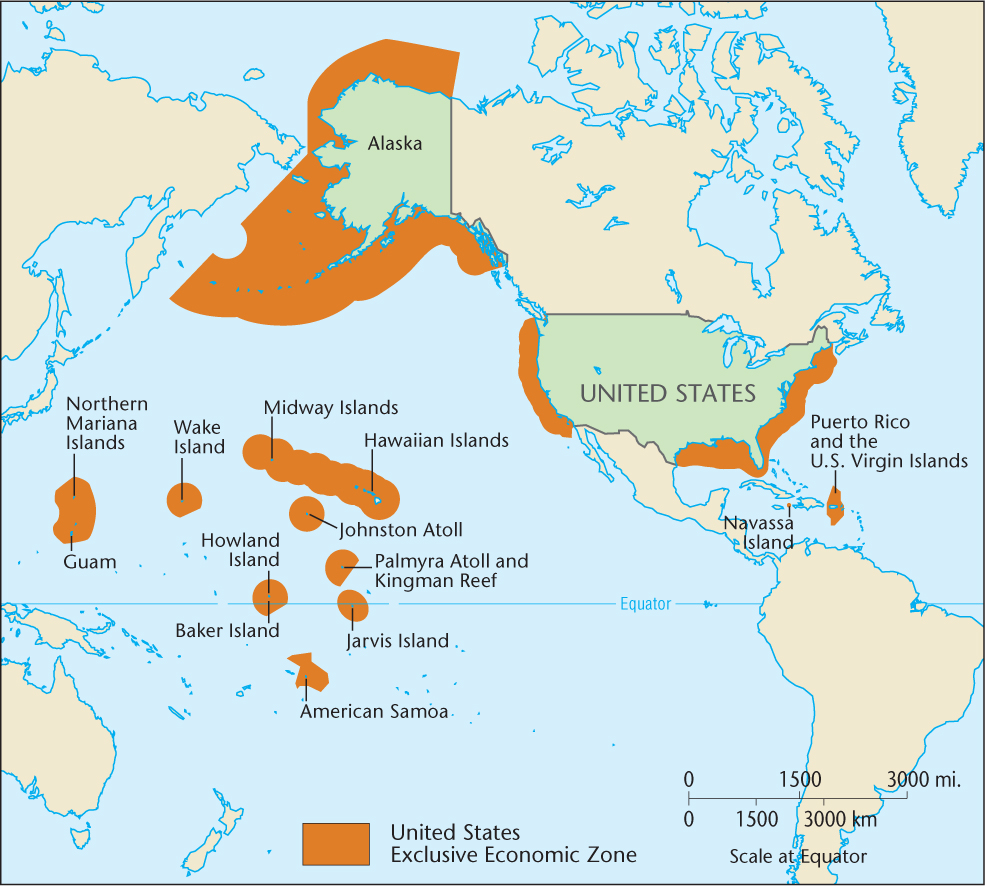
Thinking Geographically
Question 8.17
What factors might cause the delimitation and management of EEZs for the world’s many countries possessing coastlines to be politically problematic?
Nonagricultural Areas
Nonagricultural Areas
hunting and gathering The killing of wild game and the harvesting of wild plants to provide food in traditional cultures.
Areas of extreme climate, particularly deserts and subarctic forests, do not support any form of agriculture. Such lands are found predominantly in much of Canada and Siberia. Often these areas are inhabited by hunting and gathering groups of native peoples, such as the Inuit, who gain a livelihood by hunting game, fishing where possible, and gathering edible and medicinal wild plants. At one time all humans lived as hunter-gatherers. Today, fewer than 1 percent of humans do. Given the various inroads of the modern world, even these people rarely depend entirely on hunting and gathering. In most hunting-and-gathering societies, a division of labor by gender occurs. Males perform most of the hunting and fishing, whereas females carry out the equally important task of gathering harvests from wild plants. Hunter-gatherers generally rely on a great variety of animals and plants for their food.